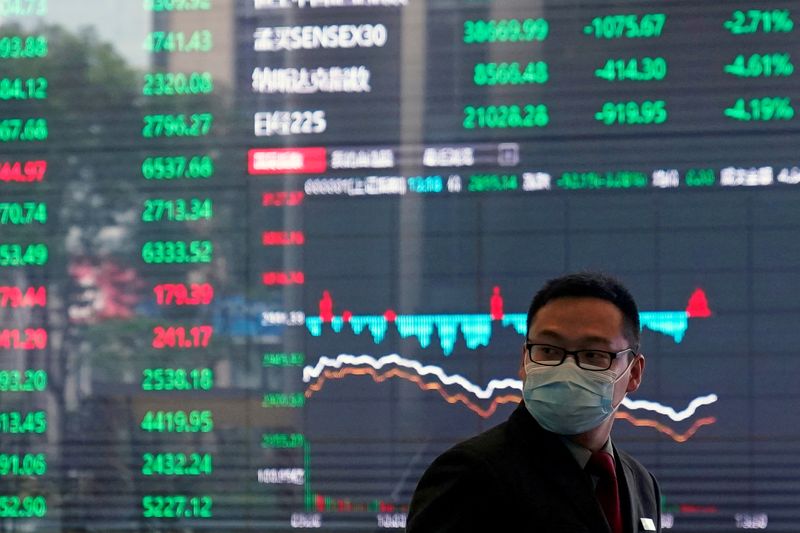By Josh Horwitz
SHANGHAI (Reuters) - China's biggest chipmaker SMIC is set to follow its staggering $6.6 billion share sale with its Shanghai market debut on Thursday, just as Sino-U.S. tension widens the chasm it wants to cross to reach global leader TSMC, industry insiders said.
Semiconductor Manufacturing International Corp (SMIC) (HK:0981) has found itself in the slipstream of a government drive to develop an independent chip industry. Its Hong Kong stock price has surged three-fold since March as investors bought into sentiment accompanying its listing plans.
Its second-biggest shareholder, the state-backed China Integrated Circuit Industry Investor Fund, signed up as the largest strategic investor of the offering which, by Monday close, had attracted 566 times as much money from retail investors as shares available.
However, SMIC's global aspirations fall under the shadow of tense Sino-U.S. relations, punctuated by tech import tariffs and coloured by a U.S. boycott of China's Huawei Technologies Co Ltd [HWT.UL] on security grounds, which threatens business between the telecom equipment maker and suppliers such as SMIC.
Even if SMIC acquired technology in its race to catch Taiwan Semiconductor Manufacturing Co Ltd (TSMC) (TW:2330), the 20-year-old firm lacks the intellectual property and process know-how to win top customers for at least a decade, experts said.
Its capital spending could more than double this year from last at $4.7 billion, S&P Global analysts estimated - just a third of TSMC's forecast spend.
"The listing is a blessing and a curse," said Mark Li, who tracks the semiconductor industry at Bernstein Research.
"They need the money to compete against TSMC, but they are competing against very strong competitors with a better reputation, and getting real returns for investors will be more difficult than it seems."
SMIC did not respond to requests for comment.
AMBITION
Targets outlined in its share-sale prospectus make Shanghai-based SMIC an outlier among peers in the chip-making business, experts said, given TSMC's technological dominance makes catching up prohibitively expensive.
Of the 46.3 billion yuan ($6.6 billion) proceeds, SMIC plans to spend 40% building a plant making 12-inch silicon wafers to produce chips with 14 and 7 nanometre technology. That would make it capable of taking high-end chip orders from the likes of Nvidia (NASDAQ:NVDA), Qualcomm (NASDAQ:QCOM) and Huawei chip unit HiSilicon.
Global Foundries and United Microelectronics, peers of comparable size, said they do not intend to develop 7 nanometre tech. Rather than aiming for such cutting-edge chips, those rivals upgraded lines and specialised in niche offerings.
"That's no accident, because they don't have the Chinese state backing that SMIC does," said Doug Fuller, who researches China's chip sector at the City University of Hong Kong.
"It's less exciting from a techno-nationalist perspective but perhaps a better commercial decision."
HUAWEI HURDLE
Of immediate risk are U.S. restrictions on firms using U.S. technology and markets that do business with Huawei.
SMIC earns up to 20% of sales from HiSilicon, showed Bernstein Research data. It also relies on equipment from Applied Materials (NASDAQ:AMAT), LAM Research, KLA, ASML and others in the United States or allied countries for which there is no Chinese substitute.
"Without those tools, it'll be almost impossible commercially to move production forward," said Li. "They'll probably be stuck with 14 nanometre, and can't move to 7 nanometre without unbearable costs."
KNOW-HOW
SMIC also lacks production know-how, experts said, both at the high end and when scaling up at the low end, given how manufacturing involves secretive fine-tuning with chip designers and equipment makers.
As a late-mover, SMIC has struggled to match TSMC in yield, or the number of working chips per a batch, industry insiders said.
A former Unisoc vice-president said the Chinese phone processor designer ordered roughly 50,000 prototype 3G chips from SMIC in 2015 with 40 nanometre technology - introduced by TSMC seven years earlier.
The chips, produced in batches of 2,500, kept coming out cracked, the ex-executive told Reuters.
"The yields were all over the place from wafer to wafer, and they had no idea how to fix it. Meanwhile we were doing 500,000 chips a day at our peak with TSMC."
Unisoc did not respond to a request for comment.

($1 = 7.0008 Chinese yuan renminbi)